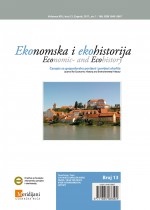THE TERRITORY ON THE RIGHT BANK OF THE DRAVA BETWEEN MARIBOR AND PTUJ IN MISCELLANEOUS SOURCES FROM THE 17TH AND 18TH CENTURY
THE TERRITORY ON THE RIGHT BANK OF THE DRAVA BETWEEN MARIBOR AND PTUJ IN MISCELLANEOUS SOURCES FROM THE 17TH AND 18TH CENTURY
Author(s): Matjaž GrahornikSubject(s): Geography, Regional studies, Physical Geopgraphy, Historical Geography, Environmental Geography, 17th Century, 18th Century
Published by: Društvo za hrvatsku ekonomsku povijest i ekohistoriju - Izdavačka kuća Meridijani
Keywords: Drava river; Drava field; parish registers; rafting; Herberstein(s);
Summary/Abstract: The paper presents the area between two towns, Maribor and Ptuj, located on the right bank of the river Drava during the (late) 17th century until the end of the 18th century. Data obtained from the oldest preserved parish registers of the Dravsko polje area (i.e. parishes Hoče, Slivnica, Hajdina and Spodnja Polskava) and Maribor town parish give the paper an added value. All registers are from the 17th century. The paper addresses (the beginnings of) rafting on the Drava river and also the (interrelated?) number of illegitimate children in the area. This part of the Drava stream used to represent the boundary between the dominions Vurberk (Wurmberg; on the left bank) and Ravno polje (Ebensfeld; on the right bank). Drava’s stream was a lot wilder in the past. After it reached the village of Zlatoličje (Goldorf), its stream gradually slowed down and began to accumulate gravel and sand. However, the river frequently flooded the area up to Zlatoličje, which caused the constant change of its stream, formation of lethargies and new small islands of land. Arrangements between the dominions, concluded in a certain period, soon became invalid due to the constant changes of the riverbed. Cultivation of the soil near the river required special agreements on both sides. The lack of proper arrangements among the owners of the land soon led to the increasing disputes. These are particularly reflected in the murder of the Vurberk landowner count Georg Günther Herberstein. The peasants of dominion Ravno polje killed him on 31 May 1677. The murder happened after count Georg and his subjects wanted to remove the dyke of Loka creek because it supposedly limited his rights for fishing and hunting.
Journal: Ekonomska i ekohistorija - Časopis za gospodarsku povijest i povijest okoliša
- Issue Year: 2017
- Issue No: 13
- Page Range: 25-35
- Page Count: 11
- Language: English

